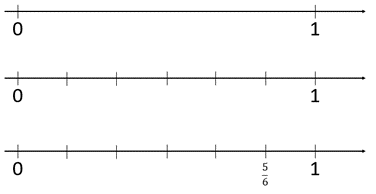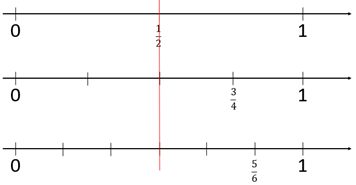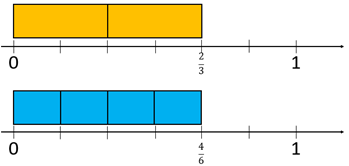The purpose of this activity is to support students in creating a mental number line for fractions, particularly non-unit fractions with the same denominators.
- Copymaster (laminated and cut into strips and cards) or a set of commercial fraction strips.
Consider how you might group students to encourage scaffolding and extension throughout these activities.
- Ask students to use the strips from the Copymaster to make a number line that locates non-unit fractions with the same denominators. A digital fraction line could be used alongside this material representation. Students might be asked to place the fractions on the number cards in their correct position, relative to the size of the strip showing one whole. For example, the number “three fifths” is located below:

- Progress to students imaging the equal partitioning of one whole. Within this, they should locate non-unit fractions up to 1 on the number line. For example, the number 5/6 (five sixths) is located below:

-
Create number lines for halves, quarters, and sixths, and incorporate relevant te reo Māori kupu (e.g. haurua - half, hauwhā - quarter, hauono - sixth). Encourage students to look for fractions that look different but share the same position. For example, the number lines show that 1/2 = 2/4 = 3/6. Fractions might "look different" by using different numbers (e.g. 1/2 and 3/6) or by showing partitions of different lengths.
What do you notice about the fractions 1/2, 2/4 and 3/6?
Can you think of other fractions that are equivalent to 1/2?
- Encourage students to notice the different names used for 1. For example, 2/2 = 3/3 = 4/4.
What is true about all the fractions that are equivalent to 1?
Next steps
- Increase the level of abstraction by progressing from using fraction strips to diagrams to symbols only.
- Ask students to explain why two fractions are equivalent (represent the same quantity).
Do they recognise the use of doubling and halving?
For example, make two thirds and four sixths.
Why are four-sixths the same amount as two thirds?
The pattern is easier to see in the symbols, 2/3 = 4/6 . Both the numerator and denominator in two thirds double to give four sixths. The numerator and denominator mean different things. It is true to say there are twice as many sixths as thirds (numerators). However, sixths are half the length of thirds so twice as many of them fit into 1 (denominators).
- Explore proximity of the fractions that can be made with the strips to benchmarks such as zero, one half and 1.
Which fraction you can make is closest to 1? How do you know?
Which fraction is closest to zero? How do you know?
Make three fractions close to one half but not equal to one half?
Which of your fractions is closest to one half?